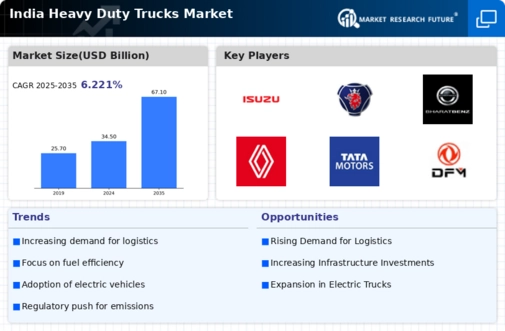Government Regulations and Policies
The Indian government has implemented various regulations aimed at improving transportation efficiency and reducing emissions, which directly impacts the heavy duty-trucks market. The introduction of stricter emission norms, such as BS-VI standards, compels manufacturers to innovate and produce cleaner vehicles. Additionally, policies promoting the use of alternative fuels, such as CNG and biofuels, are gaining traction. These regulations not only encourage the adoption of advanced technologies but also create a competitive landscape for manufacturers. As a result, The heavy duty trucks market is likely to witness a shift towards more environmentally friendly options. This shift aligns with global sustainability goals.
Rising Demand for E-commerce Logistics
The surge in e-commerce activities in India has led to an increased demand for efficient logistics solutions, thereby driving the heavy duty-trucks market. As online shopping continues to gain traction, businesses require robust transportation options to ensure timely deliveries. The logistics sector is projected to grow at a CAGR of 10-12% over the next few years, necessitating a larger fleet of heavy duty trucks. This growth is further supported by the government's initiatives to enhance the logistics infrastructure, which is expected to improve supply chain efficiency. Consequently, the heavy duty-trucks market is likely to experience a significant boost as companies invest in modern fleets to meet the evolving demands of e-commerce logistics.
Urbanization and Infrastructure Growth
Rapid urbanization in India is contributing to the expansion of the heavy duty-trucks market. As cities grow, the demand for construction materials and goods transportation increases, necessitating a larger fleet of heavy duty trucks. The government's focus on infrastructure development, including road construction and smart city initiatives, is expected to further stimulate this market. According to recent data, the Indian road network is one of the largest in the world, with over 6 million km, and ongoing investments are projected to enhance connectivity. This infrastructure growth is likely to create new opportunities for heavy duty truck manufacturers, as they cater to the rising needs of urban logistics.
Rising Fuel Prices and Economic Factors
Fluctuating fuel prices and economic conditions are pivotal drivers of the heavy duty-trucks market. As fuel costs rise, logistics companies are compelled to seek more fuel-efficient vehicles to maintain profitability. This trend is likely to push manufacturers to innovate and develop trucks that offer better fuel economy. Additionally, economic growth in India, projected at around 6-7% annually, is expected to increase freight demand, further stimulating the heavy duty-trucks market. However, economic uncertainties may also lead to cautious investment strategies among fleet operators, influencing their purchasing decisions. Thus, the interplay between fuel prices and economic factors will continue to shape the market landscape.
Technological Integration in Fleet Management
The integration of advanced technologies in fleet management is transforming the heavy duty-trucks market. Companies are increasingly adopting telematics and GPS tracking systems to optimize routes, reduce fuel consumption, and enhance overall operational efficiency. This technological shift is expected to improve the profitability of logistics operations, making heavy duty trucks more appealing to fleet operators. Furthermore, the rise of data analytics allows for better decision-making and predictive maintenance, which can significantly reduce downtime. As these technologies become more prevalent, the heavy duty-trucks market is likely to evolve, with manufacturers focusing on smart features that cater to the needs of modern logistics.





















Leave a Comment